Otakon 2014: The Panels
Movie premieres, devil cartoons, and sweet, sweet alcohol
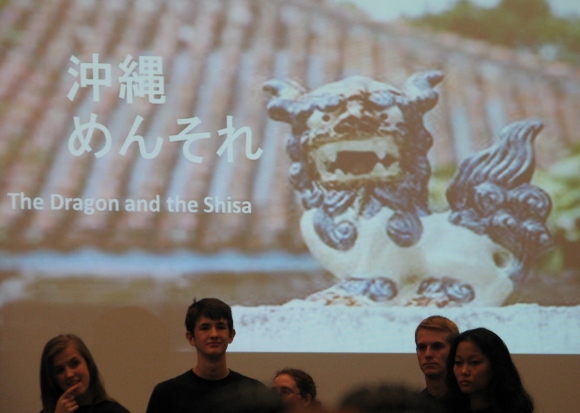
This panel report might be a little shorter than the usual. Given the number of guests and the corresponding number of Q&As and interviews for which all Ani-Gamers hands were on deck, the time we as individuals got to devote to going to other panels was all too brief. Not to mention that there was quite a bit of unwitting overlapping. Be that as it may, read on to discover some panels you might want to see at some future con, possibly next otakon, get some ideas for a panel you might wanna do, or whatever else. Hey, we just write the words. What you do with ’em is up to you.
Intro To Josei
It’s great to see some light being shed on josei titles, media targeting later teenage to adult female readers or featuring likewise-aged protagonists, but it’s a shame that it had to be Friday’s sunrise which did so. Even though it started the con off as one of the first (of seven) panels offered at 10 am (so it wasn’t arguably that early), the room was decently full; a few empty chairs allowed latecomers like myself and Evan to find seats. While we were only ten to fifteen minutes late, it was clear via slideshow hiccup that we had already missed a barrage of content. The format was simple enough: breaking down josei titles into sub-genres—Slice of Life, Theatrical/Dramatic, Historical, Supernatural, Fantasy, Weird—with two recommendations cited in detail for each and some other glossed-over honorable mentions. Presenters McKenzie and Jean made an effort to avoid recommending familiar titles, but still veered into the mainstream (Kids on the Slope, Karneval) on occasion. The limited smattering of applause and woots from the audience showed that most chosen titles were, indeed, new to the audience. So great job there! Also, the back-and-forth and jovial attitude of the presentation made for a fun and fluid atmosphere. The only real problems I had were the inconsistent mentioning of the manga-ka and the magazines that published their works as well as some clips that ran too long. [Ink]
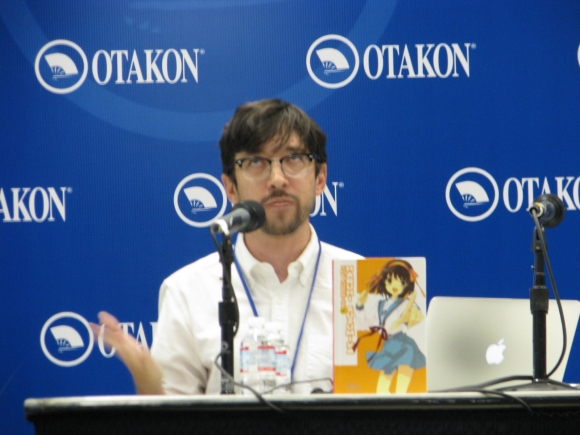 Light Novel Translation
Light Novel Translation
“Translators are at the mercy of the text,” was the quote on the screen when I walked into a panel about translating light novels. Presented by Paul Starr, translator for such notable light novel series as Haruhi Suzumiya and Spice & Wolf, started off by running through some slides with the various tools he uses for his work. For each example, he explored the benefits and drawbacks as well as alternate takes afforded by each tool and then defined his own process: looking up japanese words in a japanese dictionary first and then consulting the Internet for current usage and applicable contemporary usage variations. At one point, Starr confessed, half in jest and half in earnest, that the use of Yahoo! Answers by Japanese students and teachers has been infinitely helpful. Starr also ran the audience through the frustration of what he deemed the second step in his process: “Deciding how to say it in English.” Here he spoke to challenges, including concepts, context, phrasing, references, and linguistic limitations, faced during his work on the aforementioned titles as well as the lengths to which he went in making them seem fluid and poignant to an English-reading audience. While difficult, the challenges shown by Starr illustrated the opportunity for creativity to overcome such hurdles. As he put it, “Even though you know exactly what’s being said, there’s not necessarily an obvious way to say it in English.“ Starr also noted how such creativity can cause problems even amongst “reasonable, well-informed people.” The exploration of these and other related issues, especially given the titles in focus, was a treat for word/language nerds and hopefully a catalyst for respect due to all in this role. [Ink]
Mai Mai Miracle Screening with Sunao Katabuchi
If you’ve never heard of or seen Mai Mai Miracle, a movie that adapts a novelization of Nobuko Takagi’s autobiography, watch the following and then read on:
This is directed by the same man responsible for directing Black Lagoon. And for all the adrenaline that adaptation brings to life (motion), so Mai Mai Miracle delivers an outpouring of sympathetic sentiment regarding the imagination of children, making friends, growing up, and saying goodbye. It’s not a sad movie by any means, although there is some somberness woven into the sense of nostalgic longing, but there was not a dry eye after the screening. In fact, Sunao Katabuchi (the director) took questions immediately after explaining how the movie came to be, and every single person who took the mic from his hand and asked their question did so through a voice positively choked up with emotion. The animation (Madhouse) is beautiful and imaginative, the score is a sublime complement, and the script for the children is incredibly true to childhood. As much as Katabuchi made it clear in his remarks about the movie that he was attempting to preserve a specific moment in time for Takagi and the people of Yamaguchi Prefecture (where the movie takes place), the movie itself makes evident how universal childhood is and how much it still tugs at the heartstrings no matter how far the years advance us. Sadly, there were far too many empty seats in the largest video room at Otakon for this North American premiere. [Ink]
 Kurosawa: Romancing the Samurai
Kurosawa: Romancing the Samurai
Plisken and Panda of The Manly Battleships introduced filmmaker Akira Kurosawa as part of a family with samurai ties and a man who was influenced by Western cinema. The panel ran the audience though Kurosawa’s accomplishments in film and his positions while climbing the industry ladder. While intertwining information about Kurosawa’s personal life (marriage and offspring) the presenters pointed out prominent outcomes and techniques as related to the director’s various working relationships. There was a comprehensive rundown of the director’s prominent works as well as his early involvements, most of which punctuated by a short clip. In the end, the panel was more a biography than true to the theme which the title implied. This is a shame given how knowledgeable the presenters seemed regarding Kurosawa’s experiences and the overarching effects they had on his career. A little application would have gone a long way in making this one heck of a panel. [Ink]
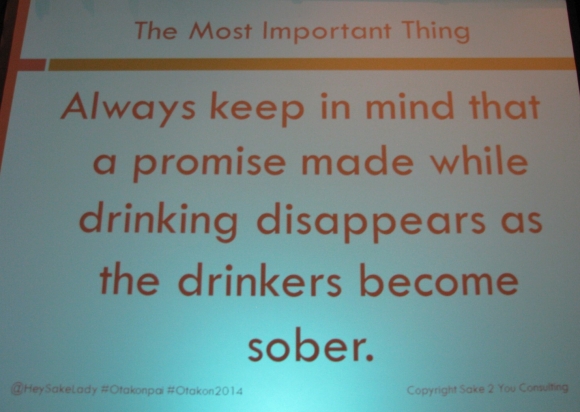 Japanese Drinking Culture: Proper Etiquette and Presentation
Japanese Drinking Culture: Proper Etiquette and Presentation
At Otakon 2013, master sake sommelier Tiffany Dawn Soto gave one heck of a general primer panel that focused on various libations available in Japan. So when I saw she was giving a panel on drinking culture at Otakon 2014, I cleared everything else from my schedule. I was not disappointed. To comply with an all-ages panel designation, Soto first imparted some knowledge about tea. This included the four basic principles—harmony, respect, purity, tranquility—as well as some notes on ceremony: dress, tools, and behavior. With that out of the way (but not irrelevant), the fun began. While “Not getting drunk is unmannerly” was the hook of the 21+ part of the presentation as well as its general tone, the presentation was more about how to be a good drunk when hosting and being hosted. Tips and pointers, learned the hard way via personal experience, were served up by Soto with a side of some self-deprecating humor concerning guest drinking order, pouring procedures, ordering and appreciating cocktails, karaoke rules, and “the art of getting home.” The latter, which builds on the aspect of respecting one’s host by not being a jerk, was the most revelatory to me. Through this, people in Japan generally pay no mind to those passed out drunk on sidewalks and other public spaces, because in their eyes, those sleeping it off are not putting anyone in harms way (as opposed to driving home). Thus they “engage in the social contract” by respecting others’ safety. Another fantastic panel! [Ink]
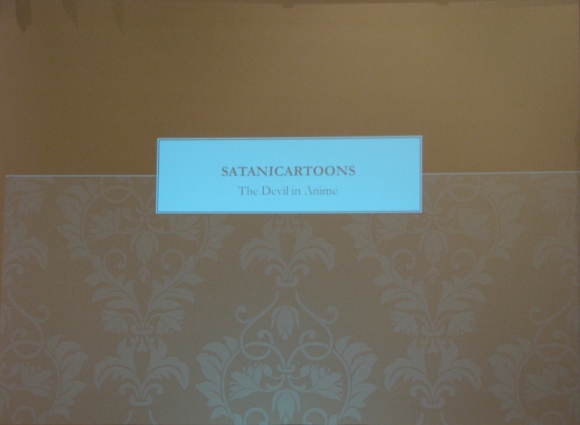 Satanicartoons: The Devil in Anime
Satanicartoons: The Devil in Anime
With all the ambiguity surrounding “Lucifer,” “the devil” and “Satan,” not to mention the frequent substituting of one name with the other in stories, most of the West has trouble distinguishing the three. Now take that confusion and apply a fuzzier Eastern filter to it, and you get Mike Toole’s Santanicartoons panel. But Toole’s done his homework, and leveraging that, as well as exploring the devil’s most basic role as adversary, Toole runs through anime, cartoon, and video games examples wherein “the devil” appears, examines what role he/it fills — superhero, monster, ideal of evil — and looks at how and to what degree those roles are leveraged. As a sort of running gauge, the multitudinous examples were strung lightly together by a judgement on whether the character was only a namesake representation or whether there was actually some embodiment of specific traits. As usual with any Toole panel, the dry delivery of humor and choice clips from his examples (from way back to recently streaming) made for an engaging and fun time. [Ink]
A Japanese Fairy Tale: The Dragon and the Shisa
Members of the Chin Hamaya Cultural Center enacted a Japanese folk tale, which takes place in Okinawa, wherein the wrath of a dragon terrorizes the citizens and a shisa comes to protect them. One person orated the tale, while others played the parts of villagers, the dragon, and the shisa. The dragon, sadly, was stolen and could not be replaced before Otakon, so the outfit made do with a smaller stuffed dragon. To the troupe’s credit, that worked just fine. The shisa was more impressive, however, as a two-man puppet (think chinese dragon costume) that combines the likenesses and traits of a lion and a dog. The mood was light, aided by some intermittent commentary by the narrator, and the tale was over way too quickly (~16 min) for all the joy it brought.
Afterwards, the troupe explained the origin of the fairy tale and its variants, showed a slideshow of Okinawa with all its shisa statues, and then went to some Q&A. After one audience member asked after the workings of the shisa costume, there were lengthy explanations of tumbling and the various acrobatics required. After that, there were demonstrations of dance with custom-made, hand-held shisas as well as another, riotous dance backed by live taiko. This was a fantastic experience. The room was full, and I hope it comes around again so more people can go see it. [Ink]
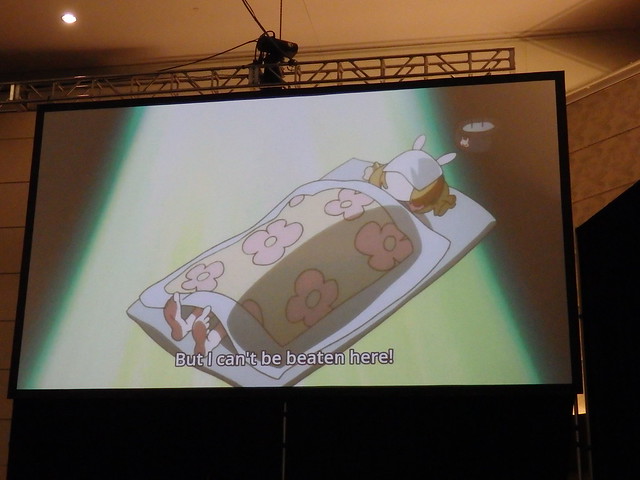
Kill la Kill: Spot the References Beginner’s Edition
Broadly speaking, there are two fields of thought when it comes to analyzing the influences and meaning of a creative work. Some critics prefer to consider the authorship of the work as basically irrelevant, instead focusing on the themes and allusions that will (consciously or otherwise) connect the reader with the text. For anyone who’s seen a Charles Dunbar (Study of Anime) panel, this is the sort of analysis he’s engaged in, connecting modern anime series with ancient mythology in unique ways. Then there’s Daryl Surat (Anime World Order), who is sometimes comically strict with his critique: the connection can only be made if there is sufficient evidence that the author(s) saw the alluded work and that it directly influenced the finished product. In keeping with that philosophy, Daryl’s superb Kill la Kill panel made a case for over a dozen references in the series by showing the originals then following them up with the Kill la Kill version, all while keeping in mind that references only count if they are a) recognizable as such and b) things that the creators would have been consciously aware of. The referenced titles included Gutsy Frog (about sentient clothing, and a favorite of Studio Trigger), Sukeban Deka (delinquent female transfer student, with an ending credits sequence from the drama series that directly mirrors KLK’s), and a double-whammy of Armored Trooper VOTOMS and Aim for the Ace! (referenced side-by-side in episode 2 of Kill la Kill). [Evan]
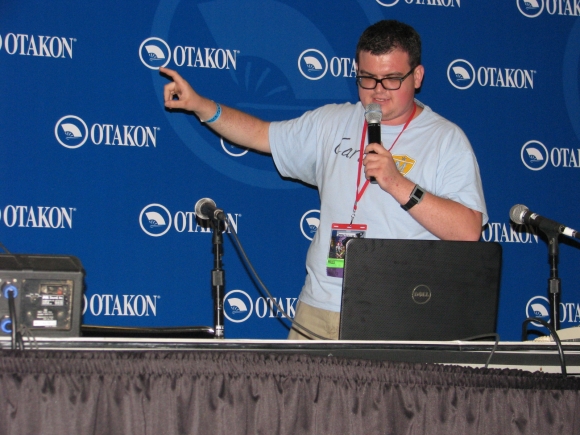 Ninjas, Spider Monsters and Cyber Criminals: The Great Worlds of Yoshiaki Kawajiri
Ninjas, Spider Monsters and Cyber Criminals: The Great Worlds of Yoshiaki Kawajiri
I will not remember this panel for its well-thought out and researched content. I will not remember this panel for all the examples of Kawajiri that define Kawajiri. I will forever remember this panel for presenter Vincenzo Averello testing the strength of the audience’s sensitivity to offensive content by rolling a clip of Detroit Metal City and gauging their reactions through squinted, judgemental eyes. After a quick (one minute?) introduction to the director’s accomplishments, the panelist launched into an exhaustive list (literally, there was no work left unexamined) of titles in which Kawajiri was involved. Along the way, Vinnie noted what role Kawajiri played in each production and pointed out his influence in short clips via poignant narration. And while I say which roles, I don’t mean to make his involvement sound limited. For as Vinnie pointed out, “Kawajiri always played 100 roles in the production process in each of these films.” Throughout all the projects, while noting Kawajiri’s most distinctive contribution to each, Vinnie also kept pointing out previously mentioned characteristics, which tied all the titles and the attention to Kawajiri’s influence together quite nicely. After exhausting Kawajiri titles, the presenter went on to select works of those Kawajiri worked with as well as his present status and rumors of future works. [Ink]
Sake
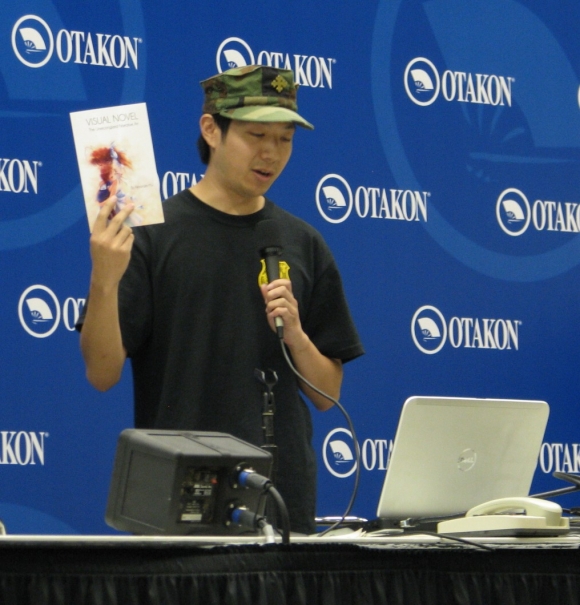 The Visual Novel: Psychology of the Unrecognized Narrative Art
The Visual Novel: Psychology of the Unrecognized Narrative Art
Building a panel around a good, though poorly supported or totally unsupported, idea is much like flushing out a poem with languid prose to justify a single line of actual consequence. Starting off with a lengthy panelist introduction might be useful if you majored in psychology and were making use of your degree, but that simply was not the case here; the psychological perspective promised in the panel description arrived almost as a footnote*. The presenter, representing the Academy of Narrative Art, looked instead at the history and evolution of methods of storytelling through aspects unique to specific mediums—novels, film, TV, comics, etc.—and then compared them with vitriol to the ALMIGHTY VISUAL NOVEL (VN). Every other medium is dead, according to the panelist. (Though to give him the benefit of the doubt, he probably just meant plateaued with regards to form and function). After noting how VNs borrow and combine specific aspects of other mediums to form the UBER MEDIUM, the presenter expounded upon the evolution of the VN. This was the breadth of the panel, which was unfortunately more history lesson than psychological analysis. Thus the panel devolved more into “The History of VN Marketing” or “Compounding Examples of How Readers are Getting Lazier.” In truth, psychology enters into both, but the presenter didn’t use the plethora of tools associated with the cited field of study to observe as much. The best points were instead very subtle, such as the mental trickery inherent in the medium: the text to sex scene bait-and-switch format or the indeterminable page count hidden by digital form factor and the (relatively) fixed-pace, click-as-you-go, choose-your-own-adventure structure—both of which make those adverse to reading do so despite their perusing preference. I wish a more solid case had been built around the most solid line to come out of the panel (*“VNs are the amplification of simplification, simplified to foster projection onto the protagonist.”), but that is not what happened. Due to its structure, this panel unfortunately was little more than a painfully transparent attempt at justifying a love of the medium via pseudo-academic posturing. I think the research necessary to make this a great panel is already there, but it needs a sharper focus and a more well-constructed argument. [Ink]
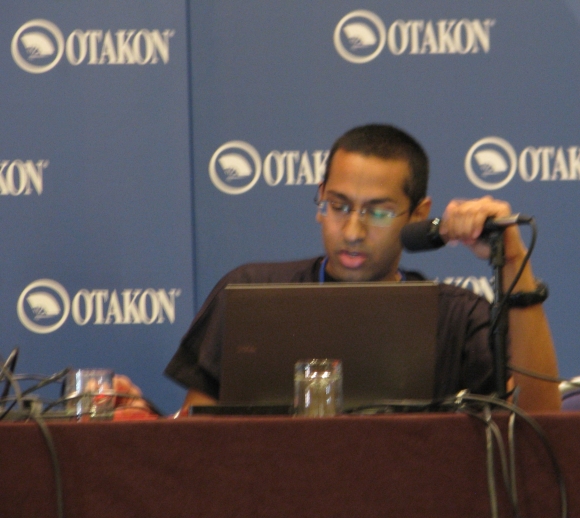 The Classic Anime and Japanese Pro Wrestling Connection
The Classic Anime and Japanese Pro Wrestling Connection
Hard Sell: Con Panel. Sunday morning. “Classic anime.” Pro wrestling. Individually, any of these three factors is not the optimal audience draw, and together they seem like a presentation that wouldn’t bring in enough people with vested interest to fill the space of a janitor’s closet. And yet, in a pretty large panel room, Daryl Surat drew and sustained a sizable crowd worthy of the room’s dimensions. What kept everyone there was the magic. No, that’s doing the panel content some major injustice. Surat built a narrative, using history as a linear guide, that took ears, eyes, and minds through a journey of artistic, social, and national consequence: televised wrestling matches, the evolution of shonen formula, its influence on sports, and on and on and on. Precise examples, some inventive connections, a clear love for all he spoke to, and the underlying historical perspective pulled every bit of offered content together to make this panel not only informative but thoroughly and unexpectedly enjoyable. [Ink]
For more of our Otakon 2014 coverage, click here.
